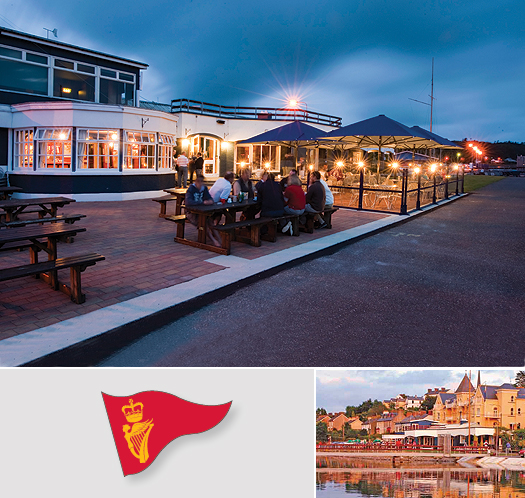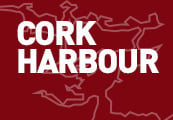
The Royal Cork Yacht Club
History
Some time in the early 1600s, the idea of sailing for private pleasure started to take root in the Netherlands. Later that century, during the Cromwellian years, King Charles II of England was in exile in the Netherlands and while there he became aware of this new and exciting pastime. In 1660 after his restoration to the English crown and return from exile, Charles was presented with a yacht called Mary by the Dutch, which he sailed enthusiastically on the Thames. Soon several of his courtiers followed his example and we feel pretty certain that one of them was Murrough O’Brien, the 6th Lord Inchiquin (Murrough of the Burnings). We know that not only had he attended the court of King Charles from 1660 to 1662, but also that he had been created the 1st Earl of Inchiquin by Charles in 1664. We also know that private sailing started to become popular in Cork Harbour shortly after his return, quite possibly because of his direct encouragement. In any case, by 1720, interest in the sport had progressed so much that his great-grandson, the 26 year old William O’Brien, the 9th Lord Inchiquin, and five of his friends got together to formalise their activities and in so doing established ‘The Water Club of the Harbour of Cork'. This club is known today as the Royal Cork Yacht Club and it is the oldest yacht club in the world.
They based themselves in a castle on Hawlbowline Island, the lease of which Lord Inchiquin held. From that castle they regulated their sailing, membership and dining affairs according to a set of rules known to us today as ‘The Old Rules’.
In the early years the majority of club sailing activity took the form of sailing in various formations, copying the manoeuvres of the navies of the day. They communicated with each other by means of flying different flags and firing cannons. Each display and sequence of flags or guns meant something and every yacht owner carried a common signal book on board, which allowed them to communicate with each other. Paintings from 1738 in the possession of the club show club yachts carrying out such manoeuvres.
Shortly before 1806 the club moved to the nearby town of Cove as the British Admiralty decided that they had a greater need for Hawlbowline Island than we had. The American Revolution and then later on the French Revolution, would have been significant factors in the Royal Navy’s decision to build up their presence in the safe and strategic harbour of Cork. Kinsale had been the main naval centre on this coast up until this time but that harbour had begun to silt badly causing problems for warships which in addition had become bigger with deeper draughts.
By 1806 the Water Club of the Harbour of Cork had started to refer to itself as the Cork Harbour Water Club. During the 1820s, following the fashion of the few other clubs that had emerged by then, it changed its name to include the word ‘Yacht’ and dropped the word ‘Water’ and became known as the Cork Harbour Yacht Club. Later on that decade it dropped ‘Harbour’ and became the Cork Yacht Club. In 1831 King William IV granted the club the privilege of using the prefix ‘Royal’ and it became known as the Royal Cork Yacht Club.
The Club had been using various premises in Cove as clubhouses but eventually, in 1854, it moved into a magnificent new building which it had built on land given to it by the then Admiral, J.H. Smith Barry. The building, which stands directly onto the waterfront, was to become not only a major yachting centre but also an essential meeting place for Cork society.
By mid century membership was keenly sought after and club records show that many candidates were disappointed. One who was fortunate to be admitted was Prince Ferdinand Maximilian of Austria, later to be Emperor of Mexico. Prince Ferdinand was a brother of Emperor Franz Joseph and was the founder of the Imperial Austrian Navy. A special meeting of the General Committee was convened on 30th November 1858 to consider if Prince Ferdinand should be allowed to go forward for ballot for membership. It was felt by many of the members that ‘the admission of Foreigners’ into the club might cause the Lords of the Admiralty to withdraw some of our privileges. After the matter was discussed for some time he was allowed to go forward and was in due course electedand admitted.
One of the very first sporting heroes, Sir Thomas Lipton, who challenged for the America’s Cup sailing his famous series of yachts called Shamrock, was admitted to the club in 1900.
By the 1960s changing economic and social patterns made Cobh less and less attractive as a base for the club. In 1966 the Royal Cork and the Royal Munster Yacht Clubs agreed to merge and the Royal Cork moved to its present premises in Crosshaven assuming the title ‘The Royal Cork Yacht Club, incorporating the Royal Munster Yacht Club’.
In the 1970s and 80s the very pinnacle of sailing competition was the Admirals Cup which was an international competition based on teams of three boats. The Royal Cork was the pivotal point for the very competitive Irish teams of those years, the right designer, builders, sail maker, crews, and owners with vision all came together at the same time and gave nations with greater resources cause for reflective thought.
The Royal Cork Yacht Club today encompasses a wide variety of sailing activities from young kids in their Optimist and Mirror dinghies sailing right through the winter months to the not-so-young kids racing National 18s and 1720s during the remaining nine months. There is also enthusiastic sailing in 470s, Int. 14s, Lasers, Laser IIs and other dinghies. The larger keelboats race on various courses set in and around the Cork Harbour area for club competitions. They also take part in events such as the Round Ireland Race, Cowes Week and the Fastnet Race.
In many far off waters, right across the globe, overseas club members proudly sail under the Royal Cork burgee. The club has a significant number of cruising members, many of whom are content to sail our magnificent south and west coasts. Others head north for the Scottish islands and Scandinavia. Some go south to France, Spain, Portugal and the Mediterranean. The more adventurous have crossed the Atlantic, explored little known places in the Pacific and Indian Oceans while others have circumnavigated the globe.
Looking forward into the 21st century, the Royal Cork goes from strength to strength, total membership is around 1500, our facilities are unparalleled in Ireland and continue to expand, major World, European and Irish Championships are hosted in the club regularly. Cork Week, which is held every two years, is regarded as Europe’s best fun regatta bar none and attracts contestants from all over the world. Recently the Royal Cork was proud to host the ISAF Nations Cup. The activities of the club are regarded as a major tourism asset for the Cork area and significantly contribute to the economy of Crosshaven. The Royal Cork may be almost 300 years old but it is still vibrant, progressive and innovative – just as it was in 1720.
(Details and image courtesy of the Royal Cork Yacht Club and Bob Bateman)
Buy the RCYC History Book here
Royal Cork Yacht Club, Crosshaven, Co. Cork. Tel: +353 21 483 1023, fax: +353 21 483 1586, email: [email protected]
Have we got your club details? Click here to get involved


























































